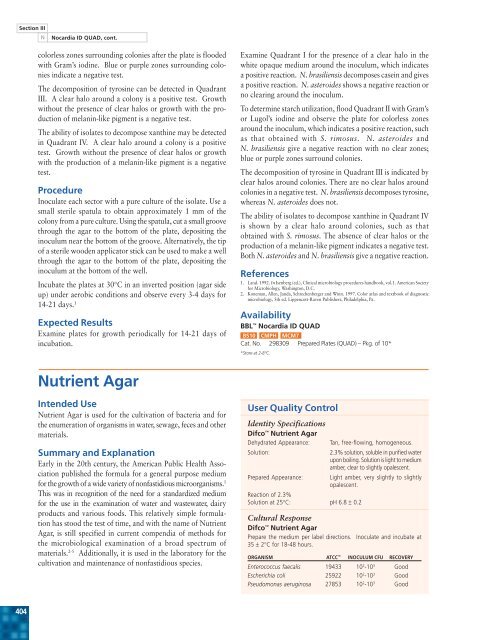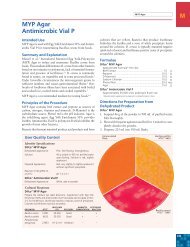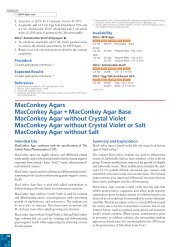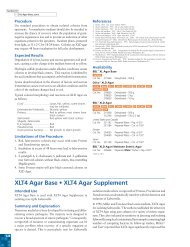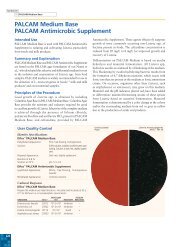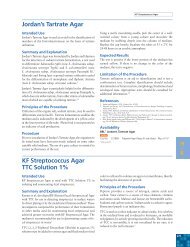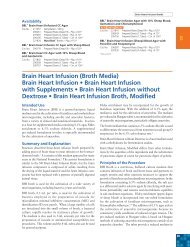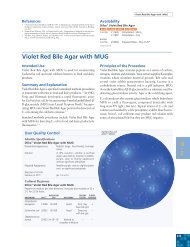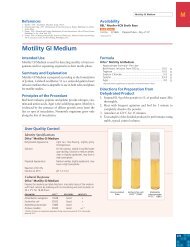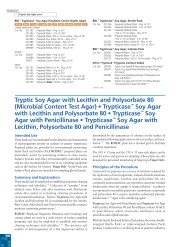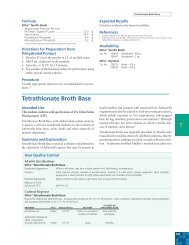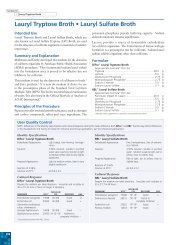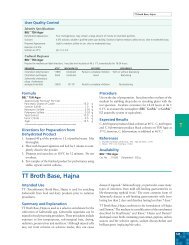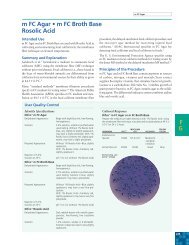Nutrient Agar 1.5% - BVA Scientific
Nutrient Agar 1.5% - BVA Scientific
Nutrient Agar 1.5% - BVA Scientific
- No tags were found...
You also want an ePaper? Increase the reach of your titles
YUMPU automatically turns print PDFs into web optimized ePapers that Google loves.
Section IIINNocardia ID QUAD, cont.colorless zones surrounding colonies after the plate is floodedwith Gram’s iodine. Blue or purple zones surrounding coloniesindicate a negative test.The decomposition of tyrosine can be detected in QuadrantIII. A clear halo around a colony is a positive test. Growthwithout the presence of clear halos or growth with the productionof melanin-like pigment is a negative test.The ability of isolates to decompose xanthine may be detectedin Quadrant IV. A clear halo around a colony is a positivetest. Growth without the presence of clear halos or growthwith the production of a melanin-like pigment is a negativetest.ProcedureInoculate each sector with a pure culture of the isolate. Use asmall sterile spatula to obtain approximately 1 mm of thecolony from a pure culture. Using the spatula, cut a small groovethrough the agar to the bottom of the plate, depositing theinoculum near the bottom of the groove. Alternatively, the tipof a sterile wooden applicator stick can be used to make a wellthrough the agar to the bottom of the plate, depositing theinoculum at the bottom of the well.Incubate the plates at 30°C in an inverted position (agar sideup) under aerobic conditions and observe every 3-4 days for14-21 days. 1Expected ResultsExamine plates for growth periodically for 14-21 days ofincubation.Examine Quadrant I for the presence of a clear halo in thewhite opaque medium around the inoculum, which indicatesa positive reaction. N. brasiliensis decomposes casein and givesa positive reaction. N. asteroides shows a negative reaction orno clearing around the inoculum.To determine starch utilization, flood Quadrant II with Gram’sor Lugol’s iodine and observe the plate for colorless zonesaround the inoculum, which indicates a positive reaction, suchas that obtained with S. rimosus. N. asteroides andN. brasiliensis give a negative reaction with no clear zones;blue or purple zones surround colonies.The decomposition of tyrosine in Quadrant III is indicated byclear halos around colonies. There are no clear halos aroundcolonies in a negative test. N. brasiliensis decomposes tyrosine,whereas N. asteroides does not.The ability of isolates to decompose xanthine in Quadrant IVis shown by a clear halo around colonies, such as thatobtained with S. rimosus. The absence of clear halos or theproduction of a melanin-like pigment indicates a negative test.Both N. asteroides and N. brasiliensis give a negative reaction.References1. Land. 1992. In Isenberg (ed.), Clinical microbiology procedures handbook, vol.1. American Societyfor Microbiology, Washington, D.C.2. Koneman, Allen, Janda, Schrechenberger and Winn. 1997. Color atlas and textbook of diagnosticmicrobiology, 5th ed. Lippencott-Raven Publishers, Philadelphia, Pa.AvailabilityBBL Nocardia ID QUADBS10 CMPH MCM7Cat. No. 298309 Prepared Plates (QUAD) – Pkg. of 10**Store at 2-8°C.<strong>Nutrient</strong> <strong>Agar</strong>Intended Use<strong>Nutrient</strong> <strong>Agar</strong> is used for the cultivation of bacteria and forthe enumeration of organisms in water, sewage, feces and othermaterials.Summary and ExplanationEarly in the 20th century, the American Public Health Associationpublished the formula for a general purpose mediumfor the growth of a wide variety of nonfastidious microorganisms. 1This was in recognition of the need for a standardized mediumfor the use in the examination of water and wastewater, dairyproducts and various foods. This relatively simple formulationhas stood the test of time, and with the name of <strong>Nutrient</strong><strong>Agar</strong>, is still specified in current compendia of methods forthe microbiological examination of a broad spectrum ofmaterials. 2-5 Additionally, it is used in the laboratory for thecultivation and maintenance of nonfastidious species.User Quality ControlIdentity SpecificationsDifco <strong>Nutrient</strong> <strong>Agar</strong>Dehydrated Appearance:Solution:Tan, free-flowing, homogeneous.2.3% solution, soluble in purified waterupon boiling. Solution is light to mediumamber, clear to slightly opalescent.Prepared Appearance: Light amber, very slightly to slightlyopalescent.Reaction of 2.3%Solution at 25°C: pH 6.8 ± 0.2Cultural ResponseDifco <strong>Nutrient</strong> <strong>Agar</strong>Prepare the medium per label directions. Inoculate and incubate at35 ± 2°C for 18-48 hours.ORGANISM ATCC INOCULUM CFU RECOVERYEnterococcus faecalis 19433 10 2 -10 3 GoodEscherichia coli 25922 10 2 -10 3 GoodPseudomonas aeruginosa 27853 10 2 -10 3 Good404
Principles of the Procedure<strong>Nutrient</strong> <strong>Agar</strong> consists of peptone, beef extract and agar. Thisrelatively simple formulation provides the nutrients necessaryfor the replication of a large number of microorganisms thatare not excessively fastidious. The beef extract contains watersolublesubstances including carbohydrates, vitamins, organicnitrogen compounds and salts. Peptones are the principlesources of organic nitrogen, particularly amino acids and longchainedpeptides. <strong>Agar</strong> is the solidifying agent.FormulaDifco <strong>Nutrient</strong> <strong>Agar</strong>Approximate Formula* Per LiterBeef Extract ................................................................ 3.0Peptone ..................................................................... 5.0<strong>Agar</strong> ......................................................................... 15.0*Adjusted and/or supplemented as required to meet performance criteria.Directions for Preparation fromDehydrated Product1. Suspend 23 g of the powder in 1 L of purified water. Mixthoroughly.2. Heat with frequent agitation and boil for 1 minute tocompletely dissolve the powder.3. Autoclave at 121°C for 15 minutes.4. Test samples of the finished product for performance usingstable, typical control cultures.ProcedureLiquefy the agar if prepared tubes are used, cool to 45-50°Cand pour into Petri dishes. Allow to solidify for at least 30minutes. Use standard procedures to obtain isolated coloniesfrom specimens. Incubate plates at 35 ± 2°C for 18-24 hoursand 42-48 hours, if necessary.<strong>Nutrient</strong> <strong>Agar</strong> <strong>1.5%</strong>Intended Use<strong>Nutrient</strong> <strong>Agar</strong> <strong>1.5%</strong> is used for cultivating a variety of microorganismsand with the addition of blood or other enrichmentcan be used for cultivating fastidious microorganisms.Summary and Explanation<strong>Nutrient</strong> <strong>Agar</strong> <strong>1.5%</strong> is a modification of <strong>Nutrient</strong> <strong>Agar</strong>. 1 Thismedium is a slightly alkaline general-purpose medium. Sincethe medium contains 0.8% sodium chloride, it can be used as abase for enrichment with blood, ascitic fluid or other supplementsfor cultivating fastidious microorganisms.Principles of the ProcedureBeef extract and peptone provide the nitrogen, vitamins, aminoacids and carbon sources in <strong>Nutrient</strong> <strong>Agar</strong> <strong>1.5%</strong>. Sodiumchloride maintains the osmotic balance so that red blood cellsgggTubed slants are used primarily for the cultivation and maintenanceof pure cultures. They should be inoculated with aninoculating loop and incubated under the same conditions asthe plated medium.Expected ResultsExamine plates for growth.Growth from tubes inoculated with pure cultures may be usedfor biochemical and/or serological testing.References1. American Public Health Association. 1917. Standard methods of water analysis, 3rd ed. AmericanPublic Health Association, New York, N.Y.2. U.S. Food and Drug Administration. 1995. Bacteriological analytical manual, 8th ed. AOACInternational, Gaithersburg, Md.3. Clesceri, Greenberg and Eaton (ed.). 1998. Standard methods for the examination of water andwastewater, 20th ed. American Public Health Association, Washington, D.C.4. Horwitz (ed.). 2000. Official methods of analysis of AOAC International, 17th ed., vol. 1. AOACInternational, Gaithersburg, Md.5. Downes and Ito (ed.). 2001. Compendium of methods for the microbiological examination offoods, 4th ed. American Public Health Association, Washington, D.C.AvailabilityDifco <strong>Nutrient</strong> <strong>Agar</strong>AOAC BAM CCAM COMPF ISO SMWW USDACat. No. 212000 Dehydrated – 100 g213000 Dehydrated – 500 g211665 Dehydrated – 2 kgBBL <strong>Nutrient</strong> <strong>Agar</strong>AOAC BAM CCAM COMPF ISO SMWW USDAUnited States and CanadaCat. No. 297801 Prepared Plates – Pkg. of 10*220968 Prepared Pour Tubes – Pkg. of 10220971 Prepared Slants – Ctn. of 100EuropeCat. No. 256035 Prepared Plates – Pkg. of 20*MexicoCat. No. 257500 Prepared Plates – Pkg. of 10**Store at 2-8°C.will not rupture when blood is added as supplement. 1 <strong>Agar</strong> isthe solidifying agent.FormulaDifco <strong>Nutrient</strong> <strong>Agar</strong> <strong>1.5%</strong>Approximate Formula* Per Liter<strong>Nutrient</strong> <strong>Agar</strong> <strong>1.5%</strong>Beef Extract ................................................................ 3.0Peptone ..................................................................... 5.0Sodium Chloride ........................................................ 8.0<strong>Agar</strong> ......................................................................... 15.0*Adjusted and/or supplemented as required to meet performance criteria.Directions for Preparation fromDehydrated Product1. Suspend 31 g of the powder in 1 L of purified water. Mixthoroughly.2. Heat with frequent agitation and boil for 1 minute tocompletely dissolve the powder.ggggN405


